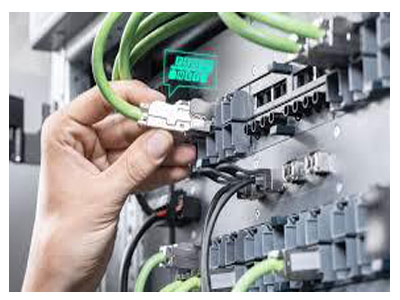Key Takeaway
PROFINET in PLC (Programmable Logic Controller) is an industrial Ethernet protocol used for high-speed communication between PLCs and devices like sensors, actuators, and machines. It is designed for real-time data exchange, making it ideal for automation systems requiring precision and reliability.
PROFINET supports both cyclic and acyclic communication, allowing PLCs to control processes while also managing diagnostics and configuration. Its real-time capabilities ensure minimal delays, which is essential for tasks like motion control or robotic operations. PROFINET is widely used in industries for its scalability, flexibility, and compatibility with a variety of devices.
Introduction to PROFINET: An Ethernet-Based Protocol
PROFINET stands for Process Field Net and is built on standard Ethernet technology. Unlike conventional Ethernet, which focuses on general data transmission, PROFINET is tailored for industrial environments.
The protocol ensures fast, reliable communication between PLCs and field devices, even in demanding conditions like factories with high temperatures, vibrations, or electrical noise. Its deterministic nature allows it to deliver time-critical information precisely when needed.
What makes PROFINET unique is its adaptability. It supports different communication speeds, from real-time (RT) to isochronous real-time (IRT), depending on your system’s requirements. Whether you’re automating a small machine or managing a complex production line, PROFINET scales effortlessly to meet your needs.
For beginners in the industry, understanding that PROFINET combines the robustness of industrial networks with the simplicity of Ethernet is the first step to mastering this technology.

An Ethernet-Based Protocol H2: How PROFINET Enhances PLC Communication
PROFINET revolutionizes how PLCs communicate in industrial setups. At its core, it ensures seamless data exchange between devices, enabling automation systems to perform efficiently and reliably.
Real-Time Communication: One of PROFINET’s standout features is its ability to transmit data in real-time. This is especially important for applications like motion control, where even a millisecond’s delay can disrupt operations.
Device Interoperability: PROFINET follows global standards, allowing devices from different manufacturers to work together without compatibility issues. This flexibility reduces integration headaches.
Diagnostics and Troubleshooting: With built-in diagnostics, PROFINET simplifies identifying and resolving issues. Engineers can monitor system performance and detect faults remotely, minimizing downtime.
Flexible Topology: Whether you’re working with star, line, or ring network configurations, PROFINET adapts easily, making it suitable for a variety of industrial layouts.
For example, in a packaging line, PROFINET ensures that the conveyor belts, labeling machines, and robotic arms communicate seamlessly, keeping the operation smooth and efficient.
How PROFINET Enhances PLC Communication H2: Benefits of PROFINET in Real-Time Industrial Automation
How PROFINET Enhances PLC Communication
H2: Benefits of PROFINET in Real-Time Industrial Automation
Benefits of PROFINET in Real-Time Industrial Automation H2: ApplicationsWhere PROFINET Optimizes PLC-Based Systems
PROFINET finds applications across industries, thanks to its versatility and reliability. Here are some areas where it truly shines:
Factory Automation: In manufacturing, PROFINET connects PLCs with sensors, actuators, and machines, ensuring smooth operation. Its real-time capabilities are vital for tasks like assembly and quality control.
Process Automation: Industries like oil and gas, chemical production, and wastewater treatment rely on PROFINET for continuous monitoring and control. It handles large amounts of data efficiently, even in distributed systems.
Motion Control: High-precision applications, such as robotics and CNC machining, benefit from PROFINET’s deterministic communication. It ensures synchronization between devices, enabling accurate and smooth movements.
Infrastructure Projects: PROFINET is also used in applications like traffic control systems and building automation, where reliability and scalability are essential.
For instance, in the automotive industry, PROFINET helps manage complex production lines where robots, conveyor belts, and inspection systems need to communicate flawlessly to assemble vehicles.
ApplicationsWhere PROFINET Optimizes PLC-Based Systems H2: Integrating PROFINETWith Other PLC Protocols
One of PROFINET’s strengths is its ability to integrate with other protocols, enhancing system flexibility. In industrial automation, no single protocol fits all applications. Combining PROFINET with others allows you to leverage the best of both worlds.
For example:
Modbus Integration: PROFINET can coexist with Modbus TCP, which is often used for supervisory systems like SCADA. This ensures seamless communication between field devices and higher-level systems.
PROFIBUS Compatibility: PROFINET and PROFIBUS often work together in hybrid setups. While PROFIBUS handles legacy systems, PROFINET manages advanced, Ethernet-based devices.
OPC UA for Data Exchange: When broader data exchange is required, PROFINET can integrate with OPC UA, enabling secure communication with cloud platforms and IoT systems.
Integrating PROFINET doesn’t mean overhauling existing systems. Instead, it enhances them by adding modern capabilities like real-time communication and remote diagnostics. For new engineers, understanding how to bridge different protocols is a valuable skill that ensures seamless system upgrades and expansions.
Conclusion
PROFINET is more than just a protocol—it’s the backbone of modern industrial communication. It bridges the gap between Ethernet’s simplicity and the demanding needs of real-time automation.
For new engineers in the field, mastering PROFINET opens the door to creating smarter, faster, and more reliable systems. Whether you’re designing a small automation project or managing a large industrial plant, PROFINET equips you with the tools to optimize communication, enhance efficiency, and future-proof your operations.
In a world where precision and speed are paramount, PROFINET delivers—making it a must-know technology for every engineer in industrial automation.
